Death of a Dream: The crash of Air France flight 4590
Note: this accident was previously featured in episode 6 of the plane crash series on October 14th, 2017, prior to the series’ arrival on Medium. This article is written without reference to and supersedes the original.
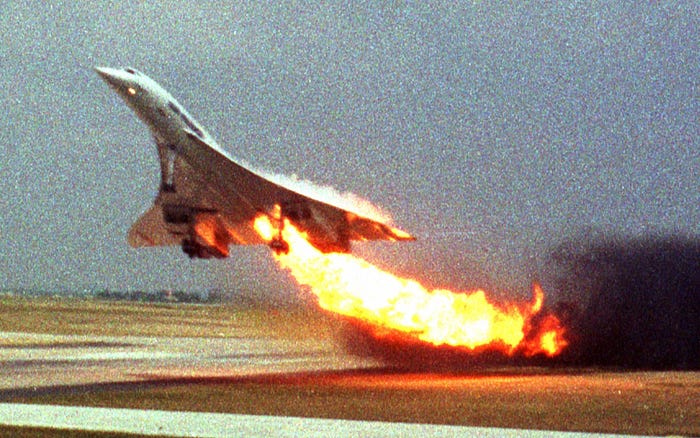
On the 25th of July 2000, travelers at Charles de Gaulle Airport in Paris watched in horror as a supersonic Concorde lifted off the runway in flames. Faced with a raging fire and two failing engines, the pilots fought to keep their unwieldy airplane aloft, hurtling along just above the ground in a desperate race against time. It was a race they could not possibly win. Less than one minute after takeoff, Air France flight 4590 stalled, spun, and crashed into a hotel in the Paris suburb of Gonesse, killing all 109 people on board as well as four on the ground.
The sudden and dramatic loss of a Concorde shocked the world. The iconic supersonic airliner had flown for 24 years without a single accident, inspiring countless millions with its beautiful shape and its Mach 2 cruising speed. That this plane, in the 21st century, should crash just moments after takeoff seemed unfathomable. Investigators would find a chain of errors that led to the disaster, from its inception weeks earlier and an ocean away aboard a Continental Airlines DC-10, to the last-minute calculations of the aircraft’s weight, to the split-second decisions made by the crew as they lifted their burning airplane off the runway, a sequence that culminated in 46 desperate seconds that would change aviation forever.
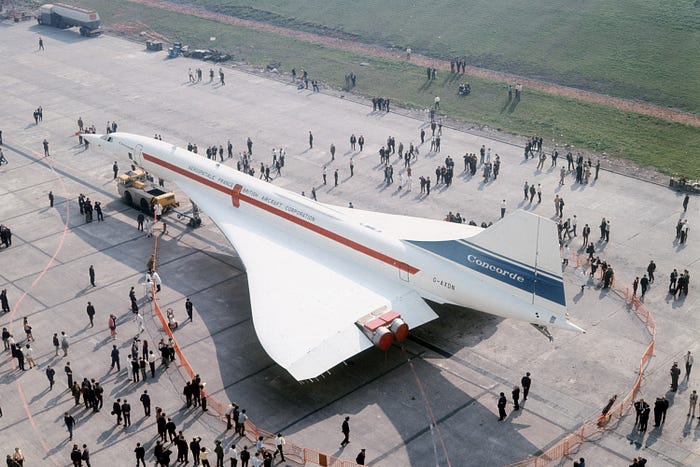
At the beginning of the 1960s, the world assumed that the nascent jet age would be little more than a stepping stone on the way to something far greater: the age of supersonic transport. Jets had cut air travel times in half, but if airliners could break the sound barrier and cruise in the zone of optimum efficiency which lay beyond it, those times could be halved again. Major governments began to explore the development of such aircraft as early as the 1950s, and manufacturers expected that within fifteen years, “supersonic transports,” or SSTs, would come to dominate the market. Boeing even designed the 747 with cargo operations in mind, expecting that it would soon become obsolete in passenger service due to the arrival of the SSTs.
But it was not to be. The engineering was sound — the basic principles of how to make an SST were already known — but the biggest barrier proved to be practicality. SSTs needed enormous runways, and they needed to fly most of their routes over water, because sonic booms over populated areas tended to cause widespread damage and popular discontent. As the number of feasible supersonic transport routes narrowed, governments and manufacturers began to lose interest, until only one Western SST remained in development: the joint British-French project known as Concorde.
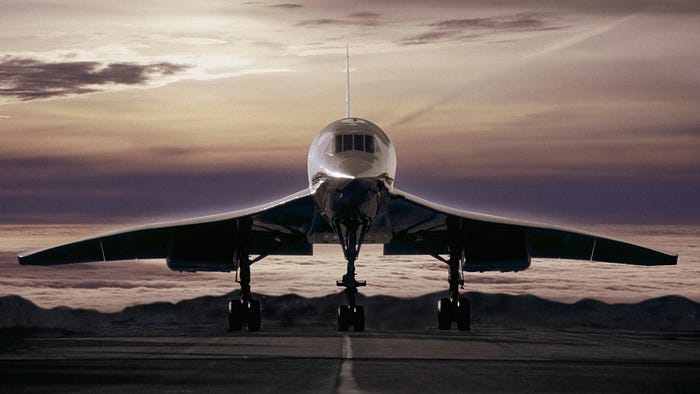
Concorde was indeed much faster than regular jets, but it never achieved the main goal of the SST, which was to be not only faster but more efficient as well. Limited to a few transatlantic routes, plagued by maintenance issues, and banned from going supersonic over inhabited areas, British Airways and Air France — the only airlines that ended up buying the Concorde — found that it was much more effective as a status symbol than as a means of transport. Concorde represented a triumph of British and French engineering and a milestone of human technological achievement, never mind that tickets were too expensive for ordinary people; the planes spent more time in maintenance than they did in the air; and all the orders from independent airlines were cancelled before it even went into service. But as soon as one caught sight of Concorde’s sleek, white form streaking overhead, all criticism melted away: the plane was beautiful, it was awe-inspiring, it was magnificent. To fly Concorde was the dream of every aspiring pilot; for prospective passengers, just being on it was enough to elicit childlike excitement. It didn’t much matter that its cabin was cramped, that its windows were tiny, or that its high-speed takeoffs and landings induced emotions ranging from mild alarm to outright terror. What did any of that mean if you could come back home and tell your friends that you flew aboard Concorde at twice the speed of sound?
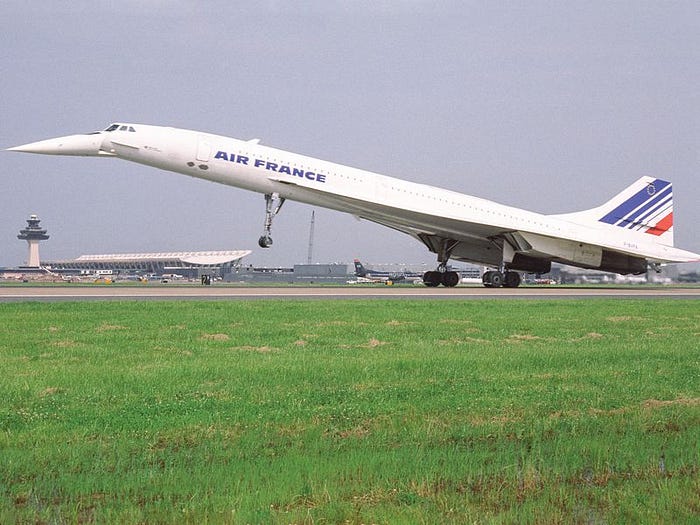
Despite the terrifying thought of something going wrong at Mach 2, Concorde was much like other planes in that takeoffs and landings were by far the most dangerous part of each flight. The plane was designed to fly at high altitudes at great speed; that was where it was at home. But on the approach to an airport, or right after takeoff, it felt and looked more like a fish trying to make its way on land. Its massive, sweeping delta wings were optimized for supersonic flight but were inefficient at low speed, and its long, aerodynamic nose had to be lowered out of the way during taxiing so that pilots could see where they were going. Furthermore, every Concorde flight required another Concorde to be on standby in case a problem arose with the first one, which happened frequently. After all, the passengers had paid for the specific privilege of flying on Concorde, and could not be placed on a normal alternative flight.
Despite all these difficulties, by the year 2000, Concorde had been in service for more than 24 years without any serious safety issues. The idea that one could simply fall from the sky was, to most, unthinkable.
◊◊◊
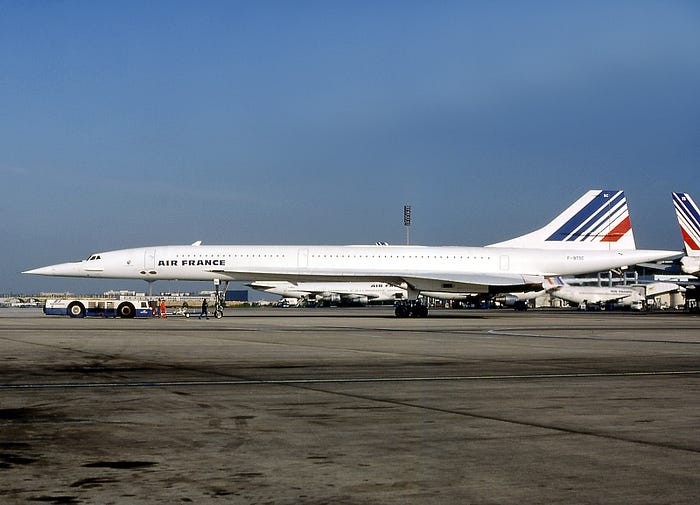
On the 25th of July 2000, one hundred passengers gathered at Charles de Gaulle Airport in Paris, ready to board Air France flight 4590, a chartered Concorde service from Paris to New York. At Concorde’s cruising speed, they could expect to arrive in New York in a little over three hours, twice as fast as a regular commercial flight. But Concorde was often delayed, and today was no exception: boarding occurred 45 minutes late in order to allow mechanics time to fix a broken thrust reverser. Nor could Air France have used the standby plane, because this was already the standby plane, the original having been pulled from service due to an unrelated mechanical problem.
The passengers were almost all German tourists who had purchased a package tour including a Concorde flight to New York, followed by a cruise to Ecuador. Some had coughed up the extremely expensive tickets without a second thought, but for others, this was a dream that had been years in the making; one couple, a pair of school teachers, had saved for two decades to afford the trip.
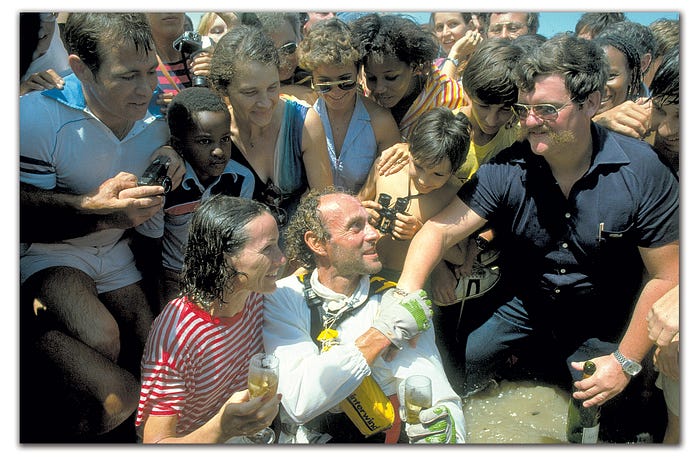
In command that day was Captain Christian Marty, who was in every way a remarkable man. Marty was not just a Concorde pilot, but also an extreme athlete; most notably, in 1982 he became the first person ever to windsurf across the Atlantic Ocean. Flying Concorde was the next logical step for the ambitious 53-year-old father of two, and he had accumulated around 317 hours on the supersonic jet since upgrading in August 1999. Joining him that day were 50-year-old First Officer Jean Marcot, who had more than 10,000 flying hours, including 2,700 on Concorde; and 58-year-old Flight Engineer Giles Jardinaud, a seasoned crewmember who had been operating Concorde systems since 1997.
On flight 4590, the crew and their dispatchers faced a difficult logistical puzzle. The plane was completely full with 100 passengers, nine crewmembers, a large load of baggage, and 95,000 kilograms of fuel, enough to fill every tank to capacity. Some wrangling of the numbers had to be performed in order to get the plane under its maximum takeoff weight of 185,070 kilograms, but even after the pilots concluded that they were within limits, a number of discrepancies remained. Nineteen bags were loaded into the aft baggage compartment without being added to the load sheet, and the pilots counted on burning the Air France standard of 2,000 kilograms of fuel during taxi, which turned out to be unrealistically high. Even without accounting for these faulty assumptions, the pilots concluded that they would take off at the structural limits of the airplane.

Expert calculations would later show that the plane was in fact operating outside its approved envelope. The real weight of the plane was at least 700 kilograms more than the maximum takeoff weight under the conditions, and the center of gravity was at least 54.2% aft, farther back than the maximum of 54%. And these were the conservative estimates — the actual exceedances might have been considerably greater. Of course, these limits are not a hard line beyond which the plane will not fly, but by going over them, the crew of flight 4590 stripped away a significant portion of the margin of error protecting their plane against unexpected events during takeoff.
No doubt with some small flicker of pride, First Officer Marcot asked the controller for permission to use the entire 4.2-kilometer-long runway 26 Right. As the plane lined up for takeoff at 16:40, Flight Engineer Jardinaud commented that they had used 800 kilograms of fuel, less than the 2,000 allotted for taxiing. Given that they were already at their max takeoff weight even without this extra fuel, the pilots should have sat at the threshold and burnt the remaining 1,200 kilograms. But instead Captain Marty simply replied, “We haven’t left yet, have we?”
After finishing up a few final checklist items, the crew received takeoff clearance at 16:42. Captain Marty advanced the throttles to takeoff power, and the four Rolls Royce Olympus engines roared to life. Passengers felt themselves pressed back against their seats as the incredible acceleration picked up the plane and hurled it down the runway. Heads turned all over the airport at the sound of that deep, earth-shaking bellow, the unmistakable sound that told everyone within several kilometers that Concorde was on the roll.
Twenty-three seconds into the takeoff run, First Officer Marcot called out, “One hundred knots,” followed nine seconds later by “V1,” the highest speed at which the takeoff could be aborted. And then, at 16:43 and 10 seconds, disaster struck.

Traveling at immense speed, the inner front tire on Concorde’s left main landing gear ran over a metal strip lying edgewise on the runway. The strip instantly sliced deep into the highly pressurized tire, causing it to disintegrate with enormous violence. Within a fraction of a second, chunks of rubber and metal began to fly in every direction, ripping through wires, damaging the landing gear doors, and smashing into the underside of the wing. Fuel immediately began to stream from a hole in fuel tank #5, streaking back in front of the engine intakes and the landing gear bays, where a short-circuiting wire, damaged by flying debris, immediately set it alight.
As a huge plume of flame erupted beneath the left wing, the ingestion of fuel and turbulent air caused both engines on that side to lose power. Violent surges rocked engines one and two as highly pressurized air from the combustion chambers forced its way back out through the inlets. The plane started to veer to the left, the asymmetric thrust and damaged left gear dragging it away from the runway centerline.
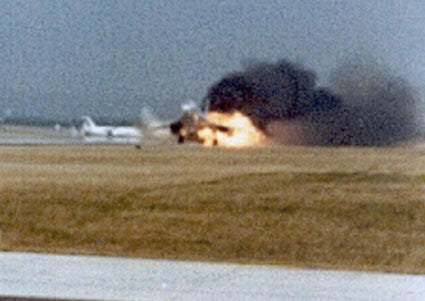
Just ahead of Concorde, stopped on a taxiway off the left side of runway 26R, was a fully loaded Boeing 747 containing French President Jacques Chirac, who had just returned from a trip to Japan.
As the crippled Concorde veered toward the 747, First Officer Marcot shouted, “Watch out!”
Captain Marty, knowing that the plane would not become airborne and would likely strike the 747 if it went into the grass, jammed the rudder hard to the right and raised the nose for liftoff. The plane was still 11 knots below its normal rotation speed, but Marty felt that he had no choice. Flight Engineer Jardinaud, aware that the plane would be in serious trouble if it took off with two dying engines, said “stop,” but his exclamation was drowned out by a message from air traffic control: “Concorde four five nine O, you have flames behind you!”
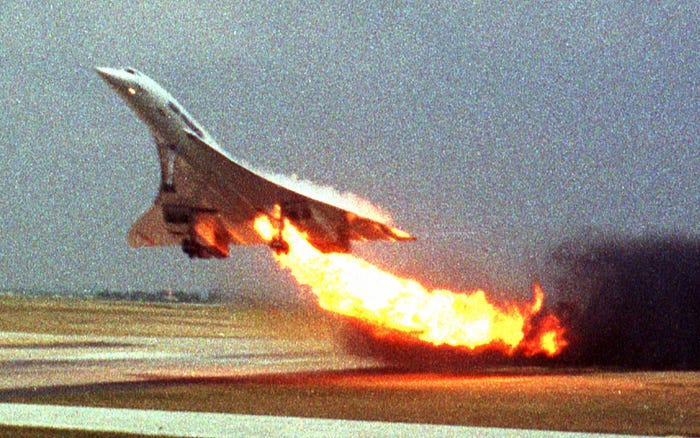
While passengers aboard Chirac’s 747 watched in horror, the burning Concorde ran over several runway edge lights and then lurched into the air, streaking past the cockpit as the pilots looked on in stunned disbelief. In the passenger cabin, someone snapped photographs of the fiery takeoff, immortalizing the moment on film.
Aboard Air France flight 4590, Flight Engineer Jardinaud announced, “Failure eng… failure engine two!” One second later, a fire alarm bell sounded as the heat of the blaze triggered the #2 engine fire warning circuit. “Shut down engine two!” he said.
“Engine fire procedure!” said Captain Marty.
Jardinaud immediately pulled the fire extinguisher handle. Simultaneously, the #1 engine, which had begun to recover from the initial surges, started to lose power again as pieces of the burning wing fell back into the engine intake and damaged the compressor blades. Their speed began to drop as the heavy airplane struggled to stay airborne with only two properly working engines. “Watch the airspeed,” First Officer Marcot shouted, “the airspeed, the airspeed!”
Over the air traffic control frequency, the pilot of another aircraft said, “It’s really burning, eh?” A few seconds later someone added, “It’s really burning and I’m not sure it’s coming from the engines.”
In order to reduce drag and increase airspeed, Captain Marty ordered, “Gear on retract!”
“Gear!” Jardinaud said.
“Four five nine O, you have strong flames behind you!” said the controller.
“Yes, roger,” said Marcot.
“The gear, Jean!” said Jardinaud. “Gear!”
“So, do as you wish,” said the controller, “you have priority to return to the field.”
“Gear retract!” Marty said again. The fire alarm in the #2 engine came back on, even though the extinguishing system had been activated.
“I’m trying!” Marcot replied. He moved the gear handle to the stowed position repeatedly, but the landing gear refused to retract. Damage to one of the gear doors prevented it from opening properly, stalling the entire gear retraction sequence.
“I’m firing it,” said Jardinaud, responding to the second fire alarm by cutting fuel flow to engine #2. Its parameters clearly showed that it was not generating power anyway.
“Are you shutting down engine two there?” Marty asked.
“I’ve shut it down,” said Jardinaud.
“The airspeed!” Marcot warned again. “The gear isn’t retracting!”

By now both engines one and two had ceased to produce power. Its remaining engines straining to keep it in the air, Concorde continued its tenuous, lurching flight, never managing to climb more than about 200 feet above the ground. As the plane passed over a cluster of airport buildings, pieces of the left wing began to fall onto the rooftops below; so low was its altitude that the flames melted the shirt of a courier caught beneath the flight path. Flight 4590 then crossed over the A1 motorway before turning to roughly parallel the southbound lanes, where a truck driver’s wife managed to capture video footage of Concorde engulfed in flames through their driver’s side window.
By this point Concorde had already embarked on an irreversible path ending in its inevitable destruction. At max takeoff weight and max aft center of gravity, with two engines out and the landing gear extended, a speed of well over 300 knots was required just to maintain altitude. The only way to reach this speed was to pitch down and descend, but there was no room to do so. At the same time, the fuel leaking from the forward tanks caused the center of gravity to creep even farther backwards, inducing an ever greater desire to pitch up, and the fire consuming the left wing was destroying its ability to produce lift. With the plane’s speed well below 200 knots and falling fast, the time remaining before disaster could be measured in seconds.
As the plane began to descend, the ground proximity warning called out, “WHOOP WHOOP, PULL UP! WHOOP WHOOP, PULL UP!”
Meanwhile, the tower tried to establish contact with the fire crews. “Fire service leader, er… the Concorde — I don’t know his intentions. Get into position near the southern double runway.”
“De Gaulle tower from fire service leader, authorization to enter twenty-six right.”
“Fire service leader, correction, the Concorde is returning on runway zero nine in the opposite direction.”
But the crew had other plans. Almost directly ahead of them lay the municipal airport of Le Bourget, only a couple kilometers out. The runway was too short for Concorde, but it was their only hope. “Le Bourget, Le Bourget!” First Officer Marcot exclaimed. Keying his mic to talk to ATC, he said, “Negative, we’re trying for Le Bourget!”
But Concorde was out of time, and out of airspeed. At that moment the plane decelerated below the minimum speed required to maintain directional control with two failed engines. The left wing dipped and the plane rolled 113 degrees to the left, spiraling inverted toward the ground. Captain Marty immediately rolled back power on engines three and four in an attempt to reduce the asymmetry and regain control, but it was too little, too late. The final word recorded on the cockpit voice recorder was First Officer Marcot’s last, desperate “No!”
Still banked steeply to the left, descending at 1,800 feet per minute with a forward airspeed of just 99 knots, Concorde plowed into the back of l’Hôtelissimo just outside Gonesse. The plane cleaved the hotel in two, throwing up a massive fireball that surged down the hallways and into the rooms as the shattered jet emerged from the other side, spewing debris across the parking lot and into a field.

Inside the hotel, panic gripped those who survived the initial impact and fireball. Four employees died instantly, including a teenager on her second day at work, but additional staff members and several guests now faced a terrifying battle to escape. Within moments the hotel was almost totally consumed in flames, and some sections immediately began to collapse in upon themselves. Guests who had just moments earlier looked up to see a burning Concorde heading straight for them now found themselves forced to jump from second-floor windows to escape the rapidly advancing fire. Witnesses who rushed to the scene managed to catch several of them as they fell, while others were able to flee through the ground floor exits.
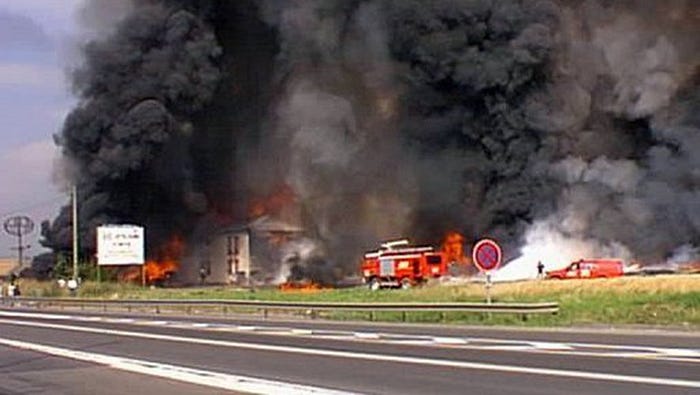

By the time fire crews arrived from the airport and nearby municipalities, the hotel and the remains of the Concorde had already mostly burned to the ground. Firefighters rushed to extinguish the flames, but it was clear that none of those aboard the plane could have survived. All 109 passengers and crew were dead, along with the four hotel employees, bringing the death toll to 113. A further six people, all staff members and hotel guests, were taken to hospital with varying degrees of injury.
The crash of the Concorde shocked the entire world. There was nothing about Concorde which made it impossible to crash, and yet nobody had imagined that it would. Grainy images of the plane, surrounded by fire as it staggered through the air, plastered the front pages of global newspapers. French authorities gave press conferences vowing a thorough investigation. But the cause, initially suspected to be an engine problem, proved to be a surprise to everyone.
Part of the story could be discerned through the pieces of Concorde which were not at the crash site, but still on runway 26 Right at Charles De Gaulle. Among them were several pieces of a tire, a section of skin from fuel tank #5, and an unidentified strip of metal. One of the tire sections displayed a transverse cut that matched the shape of the metal strip. Laboratory tests would later confirm that such a strip, laid on edge, could slice straight through a Concorde tire and cause it to burst, throwing large chunks of rubber in all directions.
Investigators identified around half a dozen previous cases involving the Concorde in which a burst tire led to damage to the wings, landing gear, or fuel tanks. Most serious among them was a 1979 incident in which a tire burst as a Concorde took off from Dulles Airport near Washington, D.C., causing debris to penetrate the fuel tanks in several locations. Fuel leaked from the wing and the crew could not retract the landing gear; however, there was no fire and no damage to the engines, so the pilots were able to turn around and land safely. The incident did however compel the manufacturer to strengthen Concorde’s tires and add protection to the wiring in the landing gear bays.
In the case of Air France flight 4590, the extent of the damage to fuel tank #5 could not be known, because most of the fuel tank was never found. However, the damage to the piece of skin found on the runway showed that it had somehow ruptured from inside to outside, the opposite of what would be expected if it were struck by a piece of debris. Extensive tests were unable to precisely replicate the mechanism, but calculations did show that some combination of debris impacts and tank penetrations could have displaced enough fuel to burst the tank. Because jet fuel is not compressible, when it is displaced by an impact it must go somewhere else, and in a full tank, a sufficiently large and sudden displacement will cause fuel to burst through the wall of the tank somewhere other than the point of entry. This was almost certainly what caused the main fuel leak aboard flight 4590.
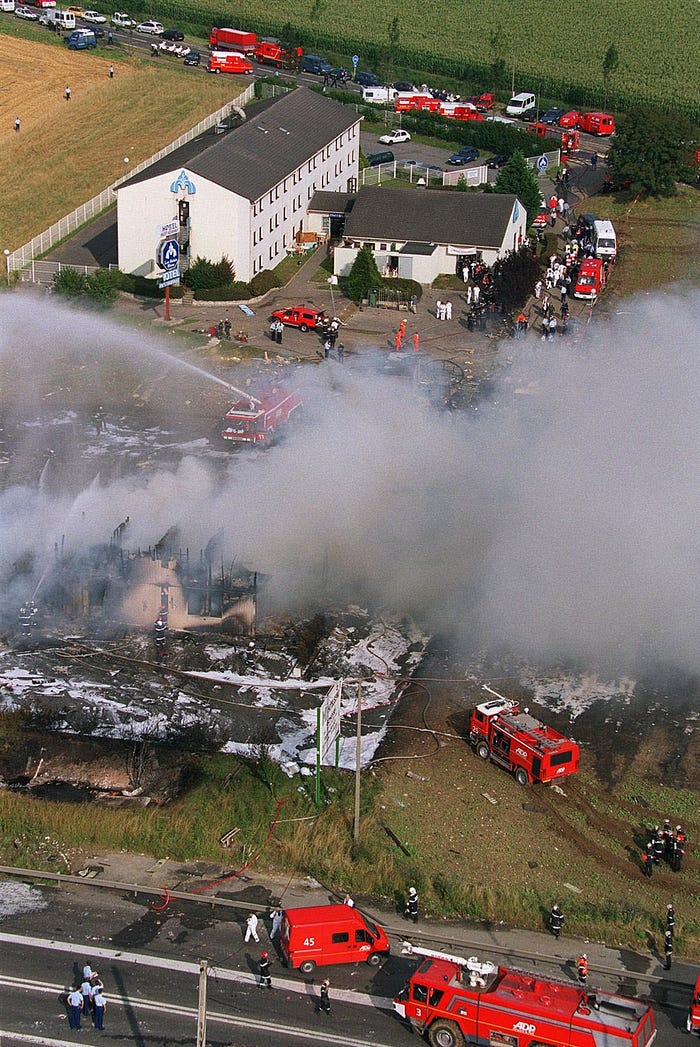
Once the fuel leak began, the vaporized fuel cloud ignited almost immediately, but British and French investigators could not agree on the cause of the ignition. French experts favored contact between the fuel and hot engine components, which required explaining how the fire propagated forward on the wing against the airflow; while British experts believed that the ignition occurred because of short-circuiting wires, which would require the flying debris to have severed wires in the landing gear bay which were specifically strengthened to withstand such an event after the 1979 incident. Both explanations are theoretically possible, but over time most accounts of the disaster have tended to settle on the British scenario.
Following ignition, engine #1 ingested debris, and both of the left engines experienced airflow disruption due to the fuel leak and fire. Several surges occurred, resulting in a significant power loss on the left side. At this point the plane was already traveling much faster than V1, and calculations showed that if the crew had attempted to stop, as the flight engineer suggested, the plane would have run off the runway at a speed of more than 100 knots while also on fire, likely resulting in mass fatalities. Whether the outcome would still have been preferable to taking off is debatable. In any case, the pilots did not have a complete understanding of the scale of the problem facing them, and could not have objectively weighed their options.

As the asymmetric thrust and damaged landing gear caused the plane to drift to the left, the captain feared a runway excursion or even a collision with the 747, explaining his decision to lift off the runway before reaching the normal rotation speed. However, this act further destabilized the tenuous flight which Concorde did manage to achieve. By this time the pilots knew that something was wrong with at least engine #2, but they had lifted off the runway before reaching the minimum climb speed with one engine out, which was 220 knots (although reaching this speed may have been impossible under the circumstances). In fact the speed of the plane peaked at 200 knots and then continuously fell until the end of the flight.
Some Concorde pilots believe that the pilots could have extracted more performance from the plane than they actually did. In response to a fire warning, Flight Engineer Jardinaud shut down engine #2 without consulting the captain and at a height of only 200 feet, despite the fact that standard operating procedures called on pilots to delay shutting down any malfunctioning engines until reaching a height of at least 400 feet above the ground. Most likely, Jardinaud was following the contradictory engine fire procedure, which instructed him to shut down the engine right away without making any mention of altitude. The problem was that engine #2, unlike its neighbor, had suffered little or no damage prior to impact, and had it not been shut down early in the flight, it could very well have recovered from its initial surges and continued to produce power for an indeterminate period of time. Would this have been enough to get them to Le Bourget? It seems doubtful, but we will never know for sure.

Once Concorde was in the air, there was very little that the pilots could do to prevent a catastrophic crash. Without enough speed to maintain altitude on two engines, the only way to keep the plane from descending into the ground was to increase the angle of attack, which in turn increased lift, but also caused the plane to lose even more speed. This deadly feedback loop continued until the speed dropped below about 157 knots, the damaged left wing stalled, and the plane rolled over into a spiral descent from which recovery was impossible. The entire flight, from liftoff to crash, lasted just 46 seconds.
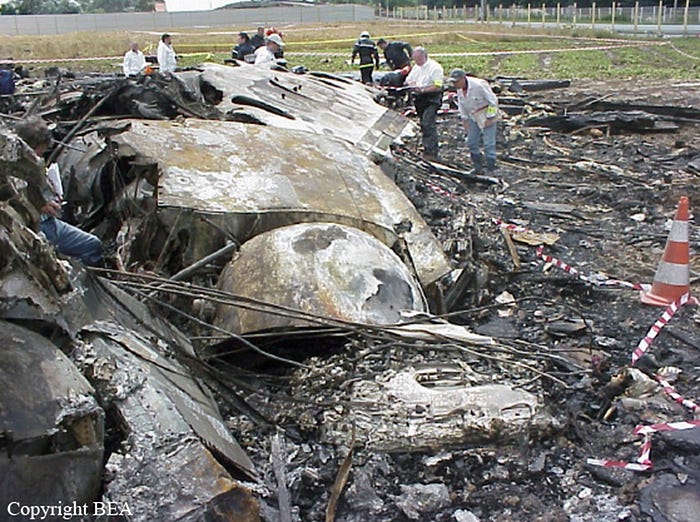
The fact that the plane was too heavy and its center of gravity was out of limits played a subtle but potentially important role in this outcome. Both of these factors increased the speed and power necessary to stay airborne, thereby hastening the final stall and loss of control. Once again, it is not possible to say for sure whether operating within limits would have bought them enough time to reach Le Bourget. But if proper accounting had been performed and the exceedance discovered, it might have proven impossible to get the weight under the limit, and the flight might not have taken off at all.
However, the BEA did note that the weight and balance issues, the pilots’ failure to acknowledge an ultimately erroneous report of a tailwind just before takeoff, and the fact that First Officer Marcot’s medical certificate had expired nine days before the flight, all suggested an informal, close-knit culture at Air France’s Concorde division which valued completing the mission above all else. If Concorde did not fly, pilots seemingly felt that they would let down themselves, their passengers, and the whole nation. Besides, what were a few extra kilograms of fuel or a few extra percentage points on the aft CG? This was Concorde; such trifles, it seemed, were beneath her.

It has also been argued that one final factor played a role in the sequence of events: a missing spacer in the left main landing gear bogie. The spacer sits on the landing gear strut and helps keep the wheels aligned correctly, but the last several flights had been undertaken without it due to a maintenance error. A few days before the crash, Air France mechanics replaced the entire landing gear bogie, an operation which had never been performed at Air France before. During the process, the spacer was removed and the mechanics simply forgot to reinstall it.
In a 2001 article in The Guardian, journalists and Concorde pilots argued that the missing spacer might have been the cause of the drift to the left which forced Captain Marty to rotate early. The article even suggested that this drift to the left began before the plane ran over the metal strip. However, photographs of the runway clearly show that staining from the fire began near the runway centerline and only began to diverge later, proving that the plane was properly centered when it first struck the object. Furthermore, the BEA, the French accident investigation agency, later calculated that even the maximum possible landing gear misalignment induced by the missing spacer would have produced negligible drag in comparison to the power delivered by the plane’s engines, and would not have resulted in a noticeable pull to the left.
One question remained, however: what was the metal strip, and where did it come from? This question quickly opened up an entirely parallel avenue of inquiry. Initial examination of the strip left investigators doubtful that it was even a part of an aircraft, given its extremely poor workmanship. It was 44 centimeters long, made out of a titanium alloy, and was covered in a red mastic adhesive; its width varied from 29 to 34 millimeters, and it contained several rivet holes of various sizes drilled at seemingly random intervals. However, the fact that it was made from titanium and was coated in aviation glue left little room for a non-aeronautical origin. Investigators eventually narrowed down the list of suspects to all the aircraft which took off from runway 26R between the last runway inspection and the departure of flight 4590.
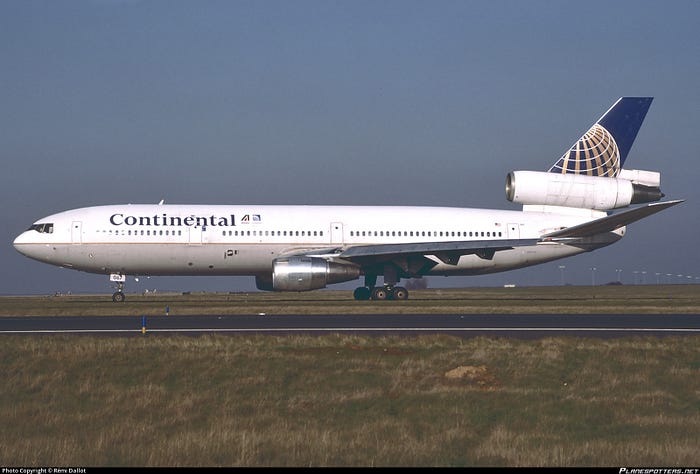
Then, on August 30th, a BEA investigator happened to spot one of these suspect airplanes parked at the gate at Charles De Gaulle Airport. The plane was a Continental Airlines McDonnell Douglas DC-10 which took off from runway 26R five minutes before Concorde on the day of the accident. Furthermore, something about the plane’s left engine looked strange. The BEA decided to track the plane down, finally catching up with it in Houston, Texas a day or two later. When they inspected the plane’s left engine, they found the smoking gun: a metal wear strip, which had been attached to the inside of the engine cowl door using red mastic, was missing.
The wear strips were relatively unsophisticated lengths of metal attached to the inside edges of the frame of the cowl door in order to absorb wear and tear in lieu of the door itself. While the plane was in flight, the door tended to oscillate slightly in its frame, causing wear to the door; but if the door closed flush against a wear strip made of a less durable material, the strip would wear down instead. Because the wear strips were so minor and expendable, mechanics were allowed to fabricate new ones directly on site, as long as they followed certain guidelines.

It turned out that several new wear strips installed on this plane in early June by a company in Tel Aviv were faulty, and just a couple weeks later a Continental mechanic saw one of them sticking out of the gap between the door and its frame, a highly abnormal position. He consequently removed the broken wear strip and set about making a new one. However, he did not follow the directions correctly: he made the strip out of titanium instead of stainless steel; he didn’t cut it evenly; and he didn’t ensure that his rivet holes corresponded to the existing holes in the support to which it was supposed to be attached. The result was a wear strip that was awkwardly shaped, full of holes that didn’t necessarily contain rivets, and barely fit into its assigned space. This type of poor workmanship appeared to be commonplace, since the wear strip next to it was too long, was missing a rivet, and didn’t sit flush with the support, which caused difficulty closing the cowl door properly.
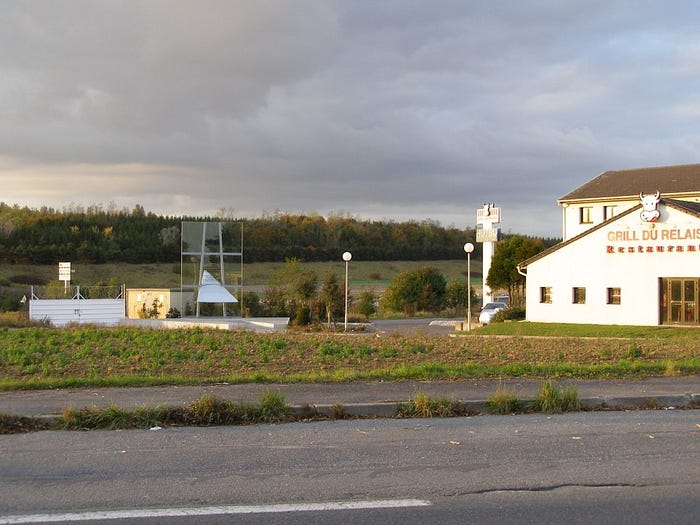
Investigators concluded that this improperly manufactured and installed wear strip worked its way loose until it finally fell off as the DC-10 sped down runway 26R at Charles De Gaulle Airport on the 25th of July. Five minutes later, Concorde ran it over.
Given the short timeframe between the deposition of the strip and the accident, it was impossible for the airport’s regular runway inspections to have caught it in time. The airport carried out runway inspections two or three times a day, roughly following guidelines published by the International Civil Aviation Organization, but France had no specific regulations pertaining to these inspections, and their effectiveness was sadly limited. The only thing that could have prevented Concorde from hitting the metal strip was an automated debris detection system, a technology which did not yet exist in 2000. In its final report, the BEA recommended that such systems be developed, and it appears that today a number of companies are selling them.
Following the publication of the BEA’s report, a French court found Continental Airlines and the mechanics who worked on the wear strip criminally liable for the disaster, and handed down several suspended sentences to those involved. However, Continental appealed, and a higher court overturned the convictions, stating that the defendants’ actions, while still exposing them to civil liability, did not rise to criminal levels. As late as 2012, however, Continental Airlines continued to argue that Concorde was on fire before it hit the metal strip and its poor maintenance had nothing to do with the accident.
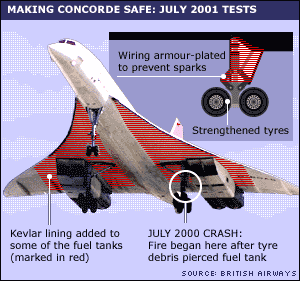
The disaster also raised safety concerns about Concorde itself. Shortly after the crash, French and British authorities grounded all Concordes until the cause of the accident could be determined. The grounding ended up lasting more than a year while the Concorde fleet was retrofitted with stronger tires and Kevlar-lined fuel tanks.
But by the time Concorde returned to service in late 2001, the world had moved on. The crash and the long grounding permanently damaged public confidence in the airplane, and increasing use of the internet was driving down demand for fast business travel between the US and Europe. Finally, the September 11th attacks resulted in a worldwide decrease in air travel, including an especially sharp drop in flights to and from New York, which was Concorde’s primary destination. Journalists and airline officials observed that Concordes were flying back and forth across the Atlantic almost totally empty. In response to these factors Airbus announced that it would stop producing spare parts for Concorde early in 2003, a move which promised to significantly increase operational costs. Even in the best of times it was hard for Air France and British Airways to consistently profit off of Concorde flights, and with this severe drop in demand and the looming lack of spare parts, they could find no good reason to continue. In April 2003, the airlines announced that Concorde would be retired, and the majestic supersonic airliner carried passengers for the last time on the 24th of October that year. As the last Concorde flight landed at Heathrow in front of an emotional crowd, reporters commented that for the first time in living memory, technology seemed to have taken a step backward.
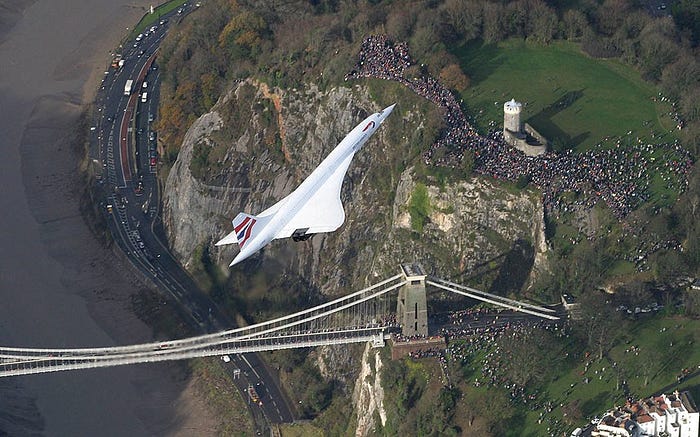
Looking back today, retiring Concorde was the right call, as hard as the decision may have been. The plane served a niche which never really existed; it was designed and built using 1960s technology; and the fleet was becoming increasingly difficult to maintain. One may rightfully question whether the retirement of Concorde was really a step backward, or simply the closing off of a technological dead-end, a fascinating but ultimately useless side track on the great railroad of progress. Other, lesser supersonic transports are in development today, but their potential use cases remain unclear, and many aviation experts doubt that they will ever be built. The speed and efficiency offered by SSTs has always paled in comparison to the drawbacks.
And yet we remain drawn to the majesty of Concorde, the soaring white bird that stood apart from all other airplanes. Concorde was not merely a plane: it was a symbol of human achievement, an expression of raw industrial beauty, and the manifest dream of a more hopeful era. But 20 years after the disaster in Gonesse, as a new generation grows up without having known Concorde’s signature earth-shaking roar, we can say that the dream died on the 25th of July 2000, on board Air France flight 4590.
________________________________________________________________
Join the discussion of this article on Reddit!
Visit r/admiralcloudberg to read and discuss over 200 similar articles.
You can also support me on Patreon.
